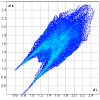Quantum computational investigation into structural, spectroscopic, topological and electronic properties of L-histidinium-L-tartrate hemihydrate: Nonlinear optical organic single crystal
- PMID: 37025852
- PMCID: PMC10070154
- DOI: 10.1016/j.heliyon.2023.e14879
Quantum computational investigation into structural, spectroscopic, topological and electronic properties of L-histidinium-L-tartrate hemihydrate: Nonlinear optical organic single crystal
Abstract
For the first time, a systematic investigation of optimization in the geometrical, vibrational, natural bonding orbital (NBO), electronic, linear and nonlinear optical properties, and Hirshfeld surface analysis for the L-histidinium-l-tartrate hemihydrate (HT) crystal is reported by employing the density functional theory (DFT). The geometrical parameters and vibrational frequencies obtained from the B3LYP/6-311++G(d,p) level of theory are in good agreement with the experimental values. The presence of strong hydrogen bonding interactions in the molecule causes an intense absorption peak in the infrared spectrum below 2000 cm-1. Quantum Theory of Atoms in Molecules (QTAIM) has been used to evaluate the topology of the electron density of a particular molecule to identify the critical points of the system using Multiwfn 3.8. These studies included ELF, LOL, and RDG studies. A time-dependent DFT approach is employed to obtain the excitation energies, oscillator strengths, and UV-Vis spectra for different solvents, such as methanol, ethanol, and water. The NBO analysis of the chosen compound, HT, is performed in terms of atom hybridization and electronic structure. The HOMO-LUMO energies and other associated electronic parameters are also computed. The nucleophilic sites are identified from MEP and Fukui functions analysis. The electrostatic potential and total density of states spectra of HT are discussed in detail. The theoretically obtained polarizability and first order hyperpolarizability values confirm that the grown material HT has NLO efficiency 15.771 times that of urea, and is proposed to be an exceptional nonlinear optical material. In addition, Hirshfeld surface analysis is performed to determine the inter-and intramolecular interactions in the title compound.
Keywords: DFT; HOMO-LUMO; Hirshfeld; Hyperpolarizability; NBO.
©2023PublishedbyElsevierLtd.
Conflict of interest statement
The authors declare that they have no known competing financial interests or personal relationships that could have appeared to influence the work reported in this paper.
Figures

















References
-
- Kanagathara N., Marchewka M.K., Anbalagan G., Ben Ahmed A., Feki H. Molecular structure, vibrational spectra and first order hyperpolarizability of anilinium L-tartrate monohydrate (ALTM) J. Optoelectron. Adv. Mater. 2017;19(3–4):251–265.
-
- Altürk S., Avcı D., Başoğlu A., Tamer Ö., Atalay Y., Dege N. Copper (II) complex with 6-methylpyridine-2-carboxyclic acid: experimental and computational study on the XRD, FT-IR and UV–Vis spectra, refractive index, band gap and NLO parameters. Spectrochim. Acta: Mol Biomol. Spectrosc. 2018;190:220–230. - PubMed
-
- Frazier C.C., Cockerham M.P. Second-harmonic generation in aromatic organic compounds. J. Opt. Soc. Am. 1987;4(11):1899–1903.
-
- Demir S., Tinmaz F., Dege N., Ilhan I.O. Vibrational spectroscopic studies, NMR, HOMO–LUMO, NLO and NBO analysis of 1-(2-nitrobenzoyl)-3, 5-diphenyl-4, 5-dihydro-1H-pyrazole with use X-ray diffractions and DFT calculations. J.Mol.Struc. 2016;1108:637–648.
-
- Oueslati Y., Kansız S., Valkonen A., Sahbani T., Dege N., Smirani W. Synthesis, crystal structure, DFT calculations, Hirshfeld surface, vibrational and optical properties of a novel hybrid non-centrosymmetric material (C10H15N2) 2H2P2O7. J.Mol.Struc. 2019;1196:499–507.
LinkOut - more resources
Full Text Sources

